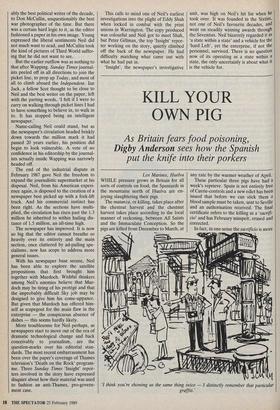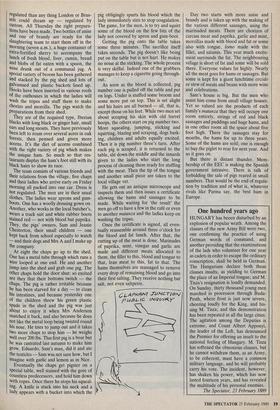KILL YOUR OWN PIG
As Britain fears food poisoning,
Digby Anderson sees how the Spanish
put the knife into their porkers
Los Marines, Huelva WHILE pressure grows in Britain for all sorts of controls on food, the Spaniards in the mountains north of Huelva are en- joying slaughtering their pigs.
The matanza, or killing, takes place after the chestnut harvest and the chestnut harvest takes place according to the local manner of reckoning, between All Saints and the Immaculate Conception. So the pigs are killed from December to March, at
any rate by the warmer weather of April.
These particular three pigs have had a week's reprieve. Spain is not entirely free of Currie-controls and a new edict has been issued that before we can stick them a blood sample must be taken, sent to Seville and an authorisation received. The final certificate refers to the killing as a `sacrifi- cio' and has February misspelt, erased and corrected.
In fact, in one sense the sacrificio is more I think you're showing us the same thing twice — I distinctly remember that particular graffiti.' regulated than any thing London or Brus- sels could dream up — regulated by custom. All Thursday the right prepara- tions have been made. Two bottles of anise and one of brandy are ready for the slaughtering team to start them off in the morning (seven a.m.), a huge container of extra-fortified sherry to accompany the lunch of fresh blood, liver, cumin, bread and blobs of fat eaten with a spoon, the wine drunk out of a communal jug. A special variety of broom has been gathered and stacked by the pig shed and lots of galvanised and plastic buckets lined up. Hooks have been inserted in various roofs of the outhouses in which the ladies will wash the tripes and stuff them to make chorizo and morcilla. The pigs watch the preparations from their shed.
They are of the required type, Iberian blacks with long black or ginger hair, small ears and long snouts. They have previously been left to roam over several acres in oak forests, then penned and given more acorns. It's the diet of acorns combined with the right variety of pig which makes the unique ham. So much so that res- taurants display the ham's foot still with its black hairs to show its race.
The team consists of various friends and their relations from the village, five chaps and their ladies who arrive early on Friday morning all packed into one car. Dress is not regulated. The men are in their usual clothes. The ladies wear aprons and gum- boots. One has a woolly dressing gown on. Another, who works in the local butcher's, wears a track suit and white rubber boots stained red — not with blood but paprika. They, the pigs' owners, Sam and Jeanie Chesterton, their small children — one kept back from school especially to watch — and their dogs and Mrs A and I make up the company.
At eight the chaps go up to the shed. One has a metal tube through which runs a wire looped at one end. He and another lump into the shed and grab one pig. The other chaps hold the door shut: so excited are they that their bottoms twitch — the chaps. The pig is rather irritable because he has been starved for a day — to clean his intestines, and because yesterday one of the children threw his green plastic spade in the shed and the pig was just about to enjoy it when Mrs Anderson snatched it back, and also because he does not like the metal loop being twisted round his nose. He tries to jump out and it takes two more chaps to stop him — he weighs well over 200 lbs. This first pig is a boar but he was castrated last autumn to make him grow. Eduardo, Sam's man, did it and ate the testicles— Sam was not sure how, but I imagine with garlic and lemon as in Nice.
Eventually the chaps get pigster on a special table, well stained with the gore of countless predecessors, and hold him down with ropes. Once there he stops his squeal- ing. A knife is stuck into his neck and a lady appears with a bucket into which the pig obligingly spurts his blood which the lady immediately stirs to stop coagulation. The game, for the men, is to try and squirt some of the blood on the few bits of the lady not covered by apron and gum-boot.
Getting the pig onto the table takes some three minutes. The sacrifice itself takes seconds. The pig doesn't like being put on the table but is not hurt. He makes no noise at the sticking. The whole process is very skilful. Indeed one of the grabbers manages to keep a cigarette going through- out.
As soon as the blood is collected, pig number one is pulled off the table and put on logs. Under is stuffed some broom and some more put on top. This is set alight and his hairs are all burned — all, that is, except those on his feet. While two men set about scraping his skin with old barrel hoops, the others start on pig number two. More squealing, jumping, sticking and squirting, blazing and scraping, dogs bark- ing, children and adults equally excited. Then it is pig number three's turn. After each pig is scraped, it is returned to the table, slit down the middle and the innards given to the ladies who start the long process of cleaning them ready for stuffing with the meat. Then the tip of the tongue and another small piece are taken to the local village vet.
He gets out an antique microscope and inspects them and then issues a certificate allowing the hams and sausages to be made. While waiting for `the result' the men go off to have a few in the café or even to another matanza and the ladies keep on washing the tripes.
Once the certificate is signed, all even- tually reassemble around three o'clock for the blood and fat lunch. After that, the cutting up of the meat is done. Marinades of paprika, mint, vinegar and garlic are made and different meats allocated to them, the fillet to this, blood and tongue to that, lean meat to this, fat to that. The hams themselves are massaged to remove every drop of remaining blood and go into their first salting. They receive nothing but salt, not even saltpetre. Day two starts with more anise and brandy and is taken up with the making of the various different sausages, using the marinaded meats. There are chorizos of carcass meat and paprika, garlic and mint, morcillas made with blood and fat or some also with tongue, lomo made with the fillet, and salamis. This year much excite- ment surrounds the fat. The neighbouring village is short of fat and some will be sold there. Everyone values fat highly. Nearly all the meat goes for hams or sausages. But some is kept for a giant lunchtime cozido or stew of meats and beans with more wine and celebrations.
Sam's house is big. But the men who assist him come from small village houses. Yet so valued are the products of each family's matanza that they will occupy one room entirely, strings of red and black sausages and puddings and huge hams, and in one other room all the space about five foot high. There the sausages stay for months, the hams for up to three years. Some of the hams are sold; one is enough to buy the piglet to rear for next year. And so it goes on.
But there is distant thunder. Mem- bership of the EEC is making the Spanish government intrusive. There is talk of forbidding the sale of pigs reared in small numbers. That would be the end of regula- tion by tradition and of what is, whatever rivals like Parma say, the best ham in Europe.

















































 Previous page
Previous page